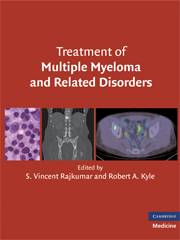Book contents
- Frontmatter
- Contents
- List of Contributors
- 1 DIAGNOSIS AND GENETIC CLASSIFICATION OF MULTIPLE MYELOMA
- 2 STAGING AND RISK-STRATIFICATION OF MULTIPLE MYELOMA
- 3 TREATMENT OF NEWLY DIAGNOSED MULTIPLE MYELOMA
- 4 MAINTENANCE THERAPY IN MULTIPLE MYELOMA
- 5 TREATMENT OF RELAPSED AND RELAPSED/REFRACTORY MULTIPLE MYELOMA
- 6 DIAGNOSIS AND TREATMENT OF MYELOMA BONE DISEASE
- 7 TREATMENT OF MYELOMA-RELATED COMPLICATIONS
- 8 AUTOLOGOUS TRANSPLANTATION FOR MULTIPLE MYELOMA
- 9 ALLOGENEIC STEM CELL TRANSPLANTATION FOR MULTIPLE MYELOMA
- 10 IMMUNOGLOBULIN LIGHT CHAIN AMYLOIDOSIS
- 11 WALDENSTRÖM MACROGLOBULINEMIA/LYMPHOPLASMACYTIC LYMPHOMA
- 12 DIAGNOSIS, RISK-STRATIFICATION, AND MANAGEMENT OF SOLITARY PLASMACYTOMA
- 13 MONOCLONAL GAMMOPATHY OF UNDETERMINED SIGNIFICANCE AND SMOLDERING MULTIPLE MYELOMA
- 14 DIAGNOSIS AND TREATMENT OF POEMS SYNDROME
- Index
- References
13 - MONOCLONAL GAMMOPATHY OF UNDETERMINED SIGNIFICANCE AND SMOLDERING MULTIPLE MYELOMA
Published online by Cambridge University Press: 11 July 2009
- Frontmatter
- Contents
- List of Contributors
- 1 DIAGNOSIS AND GENETIC CLASSIFICATION OF MULTIPLE MYELOMA
- 2 STAGING AND RISK-STRATIFICATION OF MULTIPLE MYELOMA
- 3 TREATMENT OF NEWLY DIAGNOSED MULTIPLE MYELOMA
- 4 MAINTENANCE THERAPY IN MULTIPLE MYELOMA
- 5 TREATMENT OF RELAPSED AND RELAPSED/REFRACTORY MULTIPLE MYELOMA
- 6 DIAGNOSIS AND TREATMENT OF MYELOMA BONE DISEASE
- 7 TREATMENT OF MYELOMA-RELATED COMPLICATIONS
- 8 AUTOLOGOUS TRANSPLANTATION FOR MULTIPLE MYELOMA
- 9 ALLOGENEIC STEM CELL TRANSPLANTATION FOR MULTIPLE MYELOMA
- 10 IMMUNOGLOBULIN LIGHT CHAIN AMYLOIDOSIS
- 11 WALDENSTRÖM MACROGLOBULINEMIA/LYMPHOPLASMACYTIC LYMPHOMA
- 12 DIAGNOSIS, RISK-STRATIFICATION, AND MANAGEMENT OF SOLITARY PLASMACYTOMA
- 13 MONOCLONAL GAMMOPATHY OF UNDETERMINED SIGNIFICANCE AND SMOLDERING MULTIPLE MYELOMA
- 14 DIAGNOSIS AND TREATMENT OF POEMS SYNDROME
- Index
- References
Summary
INTRODUCTION
In 1952, Jan Waldenström introduced the term “essential hyperglobulinemia” to describe patients with a small spike in the electrophoretic pattern but no evidence of multiple myeloma (MM), Waldenström macroglobulinemia (WM), amyloidosis (AL), or related disorders. Benign, idiopathic, asymptomatic, nonmyelomatous, cryptogenic, lanthanic, and rudimentary monoclonalgammopathy; dysimmunoglobulinemia; idiopathic paraproteinemia; and asymptomatic paraimmunoglobulinemia have been used to describe the entity. According to Waldenström, the protein spike remained constant in size in contrast to the increasing protein spike of the protein in MM. The entity became known as “benign monoclonal gammopathy,” but this is misleading because a monoclonal (M) protein may remain stable or it may increase and develop into symptomatic MM, WM, AL, or a related disorder. Because of this, the term “monoclonal gammopathy of undetermined significance” is a more appropriate term.
Monoclonal gammopathy of undetermined significance (MGUS) is characterized by the proliferation of a single clone of plasma cells that produces a homogeneous monoclonal (M) protein. Each M protein consists of two heavy polypeptide chains of the same class and subclass and two light chain polypeptide chains of the same type. In contrast, polyclonal immunoglobulins are produced by many clones of plasma cells. They contain all heavy chain classes and both light chain types. Each M protein consists of two heavy polypeptide chains of the same class: gamma (γ) constitutes immunoglobulin G (IgG), alpha (α) is found in IgA, mu (μ) is present in IgM, delta (δ) occurs in IgD, and epsilon (ε) is present in IgE.
- Type
- Chapter
- Information
- Treatment of Multiple Myeloma and Related Disorders , pp. 164 - 181Publisher: Cambridge University PressPrint publication year: 2008



